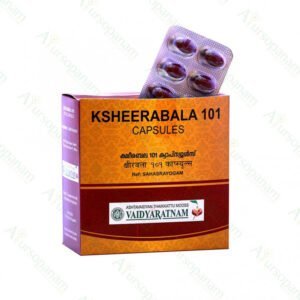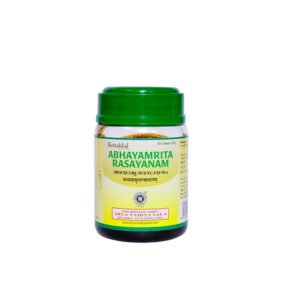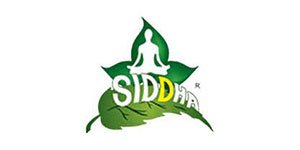Brahmi Ghritam is a ghee based herbal prepararation with Brahmi (Waterhyssop or bacopa) as the prime ingredient. Brahmi is renowned for its excellent adaptogenic properties. It nourishes and revives the brain tissue, sharpens its functions and protects it from the ravages of age and day to day stress.
Ghees or fats are widely acclaimed for their ‘Sookshma’ swabhava, the capability to reach deep into tissues and the central nervous system. It is efficient in crossing the blood brain barrier and delivering the therapeutic action in the desired sites of action. Brahmi Ghritam is used to support the treatment of ADHD spectrum of diseases and mental dysfunction.
Features & Benefits
- Brahmi Ghritam is a combination of Brahmi (Bacopa monneiri),Shunti(Zingiber officinale), Maricha (Piper nigrum) Pippali (Piper longum), Nisha (Curcuma longa), Vidanga (Embelia Ribes), Harithaki (Terminalia chebula),Trivrit (Operculina turpethum), Danti (Baliospermum montanum), Sankhapushpi (Clitoria ternata) and Nrpadruma (Cassia fistula) in a nourishing base of ghee.
- It improves alertness, concentration and focus. It improves brain and nervine health.
- Brahmi Ghritam enhances memory and retention.
- It stimulates intellect, cognition and speech.
- Brahmi Ghritam is an effective remedy for erratic activity in the brain and central nervous system.
- It is effective in managing diseases of psychosomatic origin.
- It is useful in supporting the treatment of anxiety, depression, convulsive disorders and mental dysfunction.
- It is used to boost intellectual activity in children with learning disabilities.
- Brahmi Ghritam nourishes deeply and stabilizes mental activity.
- It encourages gut motility. It improves gut biome.
Dosage and Instructions
Adult: 7-10 ml of Brahmi Ghritam early in the morning on empty stomach
Child: 5-7 ml of Brahmi Ghritam once in the morning on empty stomach.
Suitable for all ages in Physician recommended doses.
Key Ingredients
Brahmi (Bacopi monnieri)
Brahmi is used for Alzheimer’s disease, improving memory, anxiety, attention deficit-hyperactivity disorder (ADHD), allergic conditions, irritable bowel syndrome, and as a general tonic to fight stress. It is a common habit of eating Brahmi leaves for school-going children. Since the liver is the biggest agent of detoxification of the body, the compounds in Brahmi benefits the liver in this aspect. It helps by aiding the liver in its conversion of toxins into harmless ones and waste products.
Shunti (Zingiber officinalae)
Due to its strong flavour, Ginger is an essential ingredient in many Asian cuisines. Its therapeutic benefits have been recorded in Ayurvedic and Traditional Chinese Medicine. Ginger is a potent anti-nauseatic and is beneficial in treating upset stomach.Gingerol and shogaol, active components of Ginger, suppress gastric contractions. Both the fresh and dried rhizomes of Ginger suppress gastric secretion and reduce vomiting. The compounds 6-gingerol and 6-shogaol have several pharmacological properties, including antipyretic, analgesic, antitussive and hypotensive properties.
Maricha (Piper nigrum)
It is commonly known as black pepper. The common ingredient in the kitchen. Its properties include Antidepressant, Antifungal, Antidiarrhoeal, Anti-inflammatory, Antimutagenic, Anti-metastatic activity. Crushed pepper with honey relieves cold, and steam inhalation along with eucalyptus reduces chest congestion.
Haridra (Curcuma longa)
Haridra is also known as Curcuma longa. The anti-inflammatory and antioxidant properties of Haridra assist in preventing the progression of diabetes-related changes in organs like the kidneys, retina, nerve cells and minute blood vessels in the body. Turmeric is a vital herb in Ayurvedic medicine, whose spice form can be recognized by its dazzling yellow colour. The root of the herb, used either fresh or dried, has a host of medicinal benefits. It acts as a carminative and also enhances the complexion and skin tone. in addition, Turmeric can be used to combat liver damage, respiratory disorders and ulcers.
Amalaki (Embilica officinalis)
It is also known as Embilica officinalis. The benefits of Amalaki are numerous, which part of why it is considered to be the best antiaging ingredient in all of Ayurveda. It is useful in metabolism, elimination and normal liver function and excellent for the hair and skin. The fruit is an important source of Vitamin C, minerals and amino acids. It contains three times the protein concentration and Vitamin C (ascorbic acid) concentration than apple.
Vidanga (Embilia ribes)
Commonly known as false black pepper, it has various medicinal properties and is used in various Ayurvedic formulations. Vidanga is generally used to expel worms and parasites from the stomach due to its anthelmintic properties. It is beneficial for indigestion and also helps to manage constipation due to its laxative property.
Hareethaki (Terminalia chebula)
Popularly known as Indian walnut for its innumerable benefits or Indian hog plum in English, it is extremely valuable for its role in improving hair health. It is useful for treating scalp infections like dandruff, itching and hair fall. It also strengthens them from the roots, prevents breakage and loss of hair and bestows silky soft, smooth hair. Chebulic Myrobalan is one of the three key ingredients in Triphala, a natural compound that provides overall support for digestive function and helps ensure that the digestive tract works at optimal levels. The Ayurvedic Pharmacopoeia of India has documented the use of the powdered herb in intermittent fevers and chronic fevers, anaemia and polyuria. Chebulic Myrobalan can also be used to treat gastrointestinal and respiratory disorders.
Pippali (Piper longum)
Pippali is known as “Tridoshic” herb as it suits all body types. Thus regular consumption of Pippali in suggested quantity can help you to immune your body to quite an extent. Pippali has Anti-microbial, Anti-inflammatory activity. Consumption of Pippali is said to exhibit antispasmodic action and hypoglycaemic effect, which is believed to lower blood sugar level. It is also reported to be the antagonist in respiratory depression. Also, due to its cooling post-digestive effect, consumption of Pippali is considered as a safe and effective option to avoid all sorts of digestive disorders.
Trivrit (Operculina turpethum)
Commonly known as Turpeth, it is useful for easy purgation. Trivrit can be considered the best owing to its properties like strength, piercing and pungent nature. It is thus very useful in losing bodyweight. It is useful to get relief from worm infestation, constipation and healing infected wounds. Paste of Trivrit consumed in the early morning for purgation.
Shankapushpi (Clitoria ternatea)
Commonly known as ‘Butterfly Pea’, a traditional Ayurvedic medicine, it has been used for centuries as a memory enhancer, nootropic, anti-stress, anxiolytic, antidepressant, anticonvulsant, tranquillizing and sedative agent
Specialty: 100% Natural. Purely herbal. Vegetarian.





















































Ratings & Customer Reviews
Reviews
There are no reviews yet.